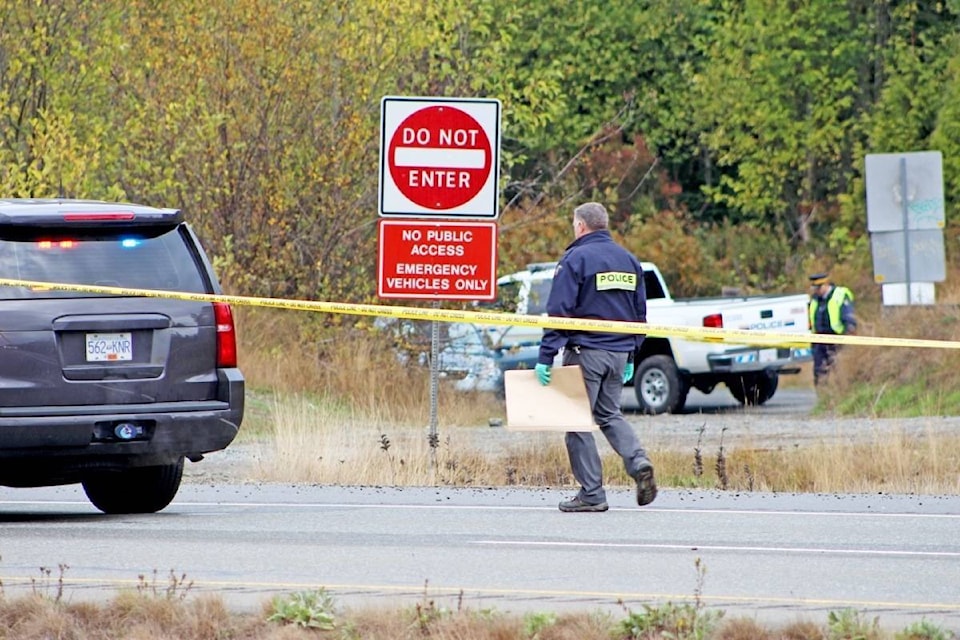A pair of Oceanside RCMP officers will not face charges following a shooting that left a man dead near Qualicum Beach in October of 2017.
Ronald J. MacDonald, chief civilian director of the Independent Investigations Office of B.C., announced the decision in a release on Monday, July 6.
Oceanside RCMP were asked to assist Emergency Health Services (EHS) at approximately 6 a.m. on Oct. 12, 2017, responding to a complaint of a man, 35, who had stabbed himself inside a vehicle on Highway 19, according to an RCMP press release at the time.
Further 911 calls informed police that the man was “running down the highway and that someone was trying to restrain him.”
READ MORE: VIDEO: IIO called to Qualicum Beach after officer-involved shooting
A confrontation at the side of the highway led to a violent struggle in which both officers were injured, leading to the man dying as a result of gunshot wounds. The IIO was notified and commenced an investigation.
The IIO report noted the man had been apprehended by RCMP members two days before, under a provision of the Mental Health Act, after becoming distressed about a recent separation from his girlfriend.
In his statement, the first officer described the officers approaching the man initially and finding him unresponsive and staring at the ground. He said as the officers were placing cuffs on each of the man’s wrists, with the intention of linking the cuffs together behind his back “[he] just lost it … we were immediately in a full-on fight.”
The officer said that in the course of the fight he was “thrown down the embankment” but was able to get back on his feet. At this point, he said, he saw that the man was on top of the second officer and was “punching down towards his face.” The first officer said even baton strikes to the man’s head were not effective in stopping the attack.
The officer said he fired a pair of shots into the ditch after the second officer shouted “he’s going for my gun!”, but the man only looked at him with a “blank stare”. The officer then discharged pepper spray into the man’s face, which only angered him and he jumped onto the officer, who claimed he feared the man would soon be able to knock him out and get control of the pistol. With the gun by his left hip, the officer said, he pointed it up into the man’s “chest/belly area.” He said he fired a round into the man, and at about that time the other officer fired a round into the man as well, from behind.
The report stated attending paramedics reported that when they arrived on scene at 6:31 a.m., they found the officers standing in the ditch with the man on the ground, unresponsive. He had two gunshot wounds and a stab wound to the chest. One paramedic told investigators that one of the officers “looked like he had the … just the ever-loving hell beat out of him. Like he had goose eggs on his head, he was bleeding, he was in visible shock.”
An autopsy showed the man had suffered five gunshot injuries in which the bullet remained in the body.
IIO investigators were able to obtain a recording from a home security system installed at a residence approximately 600 metres from the scene of the incident. The audio track from the recording provided the sequence and timing of police gunshots, though it was not possible to distinguish between shots fired by each officer.
The recording indicates three single shots spaced out over a period of approximately a minute and a half, then a space of 30 seconds, then two shots followed about five seconds later by a final group of three shots fired in a space of only about two seconds.
MacDonald noted the “conclusion is based on the evidence as a whole. There are, however, inconsistencies in some areas between witness recollections and the physical evidence. Because of those inconsistencies, it is not possible to re-create with certainty the sequence of the struggle or the precise actions of the individuals involved. However, in an intense situation involving significant physical struggle with the potential for loss of life, it is to be expected that different witnesses will recall matters differently.”
He finished by saying the evidence demonstrated that a lawful attempted detention by the two officers “turned very quickly into a violent physical confrontation because of the aggressive actions of the man”, to the point where both officers “reasonably feared grievous bodily harm or death” and resorted with justification to the use of lethal force to protect themselves and each other.
“I do not consider that there are reasonable grounds to believe that an officer may have committed an offence under any enactment and therefore the matter will not be referred to Crown counsel for consideration of charges.”
— NEWS Staff
